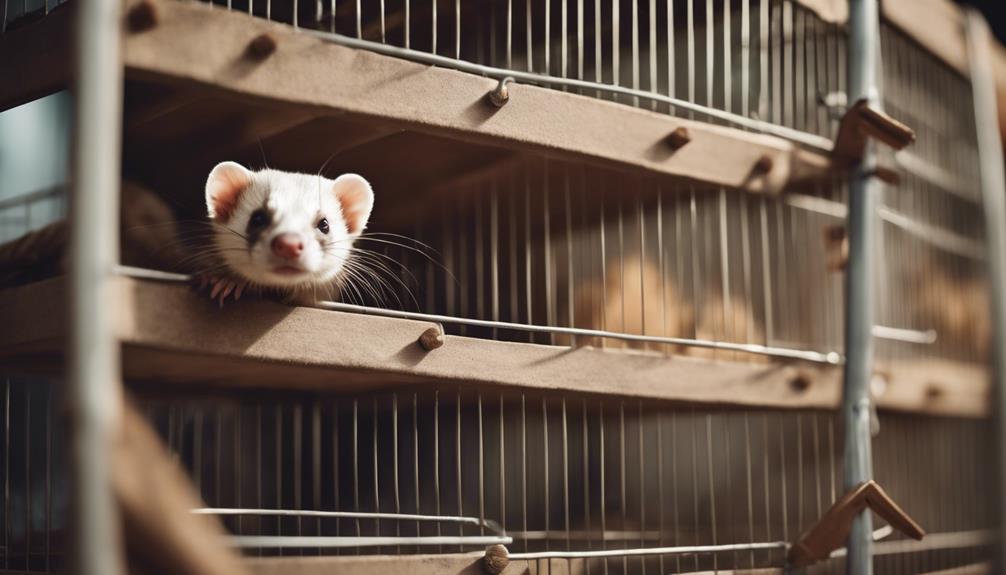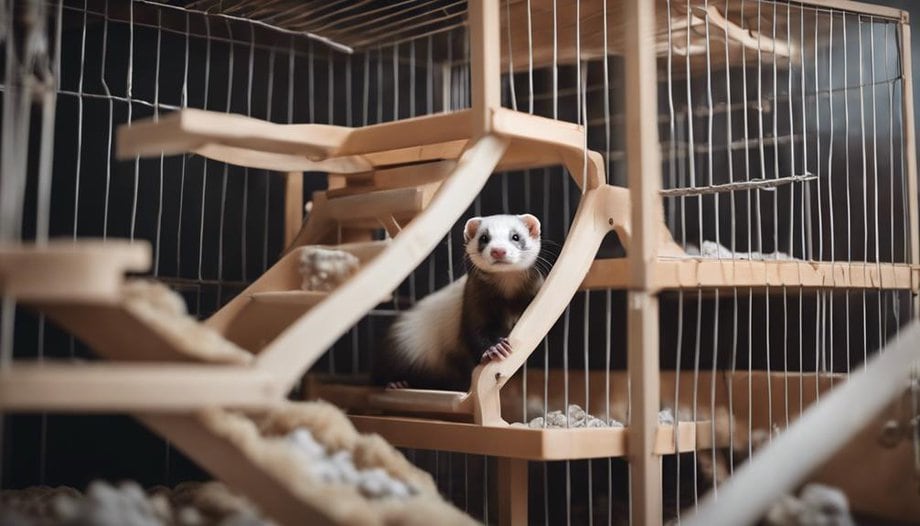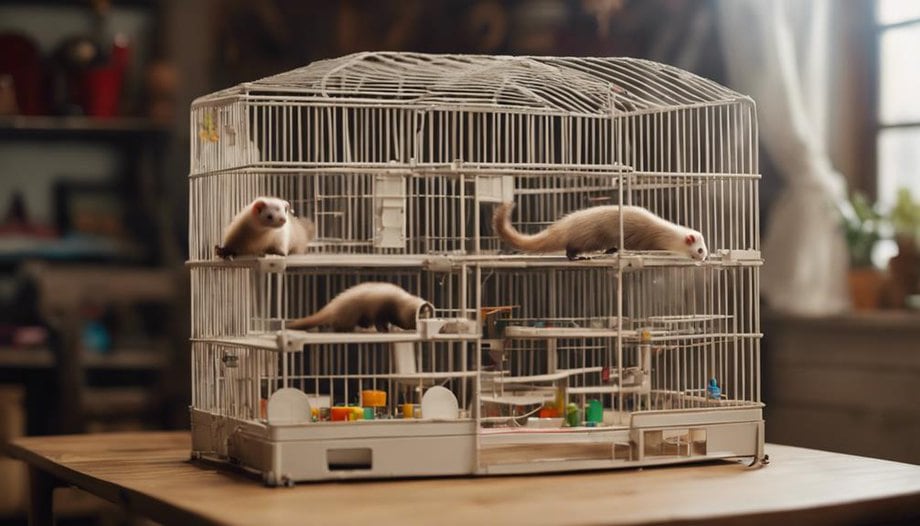How to Design a Ferret Cage That Encourages Exercise

When designing a ferret cage that promotes exercise, there are several key factors to consider. Firstly, the size and layout of the cage are crucial. A spacious cage with multiple levels, ramps, and tunnels will encourage your ferret to move around and stay active. Including hammocks, hanging toys, and other stimulating accessories can also keep your ferret entertained and engaged.
Another important aspect is the flooring of the cage. Opt for solid flooring rather than wire mesh to prevent your ferret's paws from getting injured. Regularly rotate and update toys and accessories to keep your ferret mentally stimulated and prevent boredom. Finally, make sure to provide your ferret with plenty of opportunities for play and interaction outside of the cage to ensure they get enough exercise and socialization.
Proper Cage Size and Layout
When designing a ferret cage for exercise, it's essential to consider the proper size and layout to ensure the well-being and activity levels of your furry friend. The cage dimensions should allow ample space for your ferret to move around freely. A good rule of thumb is to provide at least 24 inches by 24 inches of floor space per ferret.
Additionally, proper ventilation is crucial to maintain a healthy environment within the cage. Ensure that there are enough air holes or mesh openings to allow for adequate airflow.
When it comes to flooring options and bedding materials, choose surfaces that are safe and comfortable for your ferret. Avoid wire flooring as it can be harsh on their feet. Opt for solid flooring or use bedding materials such as fleece, paper-based bedding, or recycled paper pellets.
These options provide a soft and cozy surface for your ferret to walk on and burrow in, promoting their natural behaviors and overall well-being. By considering cage dimensions, ventilation, flooring options, and bedding materials, you can create a comfortable and stimulating environment for your ferret to stay active and happy.
Incorporating Climbing Structures

To enhance your ferret's physical activity and mental stimulation, consider incorporating climbing structures within their cage design. Ferrets are natural climbers and providing them with opportunities to climb can keep them engaged and active. Including items like rope bridges, hammocks, ladders, and tunnels can add layers to their environment, encouraging exploration and exercise.
Rope bridges are great for creating elevated pathways that encourage your ferret to move around vertically. Hammocks provide cozy spots for rest but also double up as climbing challenges. Ladders offer a way for ferrets to reach different levels within the cage, promoting movement and agility. Tunnels add an element of fun and mystery, allowing your ferret to navigate through various spaces.
Adding Interactive Toys and Tunnels

Wondering how to keep your ferret engaged and active while inside their cage? One effective way is by incorporating interactive toys and tunnel mazes to stimulate their natural curiosity and encourage physical activity.
- Tunnel Mazes: Ferrets love exploring and navigating through tunnels. Adding a variety of tunnels in different shapes and lengths can provide mental and physical stimulation for your furry friend.
- Toy Rotation: Keep your ferret's interest piqued by regularly rotating their toys. Introducing new toys or changing the arrangement of existing ones can prevent boredom and promote playfulness.
- Interactive Toys: Toys that encourage problem-solving and provide opportunities for play can keep your ferret mentally engaged. Consider toys that dispense treats or require manipulation to access rewards.
- Hide-and-Seek Games: Engage your ferret's natural hunting instincts by incorporating hide-and-seek games into their playtime. Hide treats or toys in different parts of the cage to encourage exploration and activity.
Utilizing Multi-Level Platforms

To enhance your ferret's cage environment and promote increased physical activity, consider utilizing multi-level platforms for them to climb and explore. Multi-level platforms provide opportunities for your furry friend to engage in natural behaviors such as climbing and jumping, which can help keep them active and entertained. When setting up these platforms, ensure they are securely attached to the cage walls to prevent any accidents. Here are some safety precautions and maintenance tips to keep in mind:
| Safety Precautions | Maintenance Tips | |
|---|---|---|
| Check platform stability regularly to prevent falls | Clean platforms weekly to remove any dirt or waste buildup | |
| Avoid sharp edges or rough surfaces that could injure your ferret | Inspect platforms for wear and tear and replace if necessary | |
| Use non-toxic materials for the platforms | Trim your ferret's nails to prevent snagging on the platform surfaces | |
| Place platforms at varying heights to encourage climbing and exploration | Rotate toys and accessories on the platforms to keep your ferret's interest |
Including Exercise Wheels

When considering exercise wheels for ferrets, it's crucial to choose the right wheel size to prevent potential injuries.
Proper installation techniques ensure the wheel is securely attached, providing a safe environment for your furry friend to exercise.
Understanding these points will help create a stimulating and safe space for your ferret to stay active.
Wheel Size Selection
What factors should be considered when selecting the appropriate wheel size for a ferret's exercise needs?
When choosing a wheel size for your ferret's cage, consider the following:
- Ferret Size: Ensure the wheel is large enough for your ferret to run comfortably without arching its back.
- Safety Features: Opt for wheels with solid surfaces and no gaps to prevent injury to your ferret's paws or tail.
- Material Durability: Select a wheel made from sturdy materials to withstand the ferret's activity levels.
- Noise Reduction: Look for wheels designed to operate quietly to avoid disturbing both your ferret and yourself during the night.
Proper Installation Techniques
Consider incorporating a sturdy mounting bracket to securely attach the exercise wheel within the ferret cage to ensure stability and safety during your ferret's playtime. Proper installation techniques are crucial for preventing accidents and ensuring that your ferret can exercise safely. Here is a table outlining some key factors to consider when setting up your ferret's exercise wheel:
| Installation Techniques | Description |
|---|---|
| Cage Ventilation | Ensure the wheel does not obstruct airflow. |
| Lighting | Place the wheel in a well-lit area for visibility. |
| Flooring Material | Choose a non-slip surface for the wheel's base. |
| Cleaning | Regularly clean the wheel to prevent bacteria buildup. |
Providing Hideouts and Resting Areas

To ensure your ferret feels secure and comfortable, incorporate multiple hideouts and resting areas within the cage design. Ferrets are playful creatures but also need their own space to relax and unwind. Here are some key tips to create a cozy environment for your furry friend:
- Cozy Hideaways: Provide small enclosed spaces like tunnels or igloos where your ferret can retreat for some alone time.
- Relaxation Spots: Include hammocks or shelves at different heights to offer varied spots for your ferret to rest and observe their surroundings.
- Comfy Bedding: Line these hideouts and resting areas with soft bedding material such as fleece or old t-shirts for added comfort.
- Nap Zones: Designate specific areas within the cage where your ferret can curl up and take peaceful naps throughout the day.
Regular Cage Enrichment and Rotation

Regularly enriching and rotating your ferret's cage setup ensures a stimulating environment that promotes their physical and mental well-being. Providing enrichment variety and exercise rotation is essential to keep your ferret engaged and active. Introducing new toys, tunnels, and climbing structures regularly can prevent boredom and encourage exploration. Ferrets are curious animals that thrive on stimulating play, so offering diverse activities like puzzle feeders, interactive toys, and rotating play items can keep them mentally sharp and physically fit.
Consider setting up a schedule to rotate toys and rearrange the cage layout every few days to prevent habituation and maintain interest. This simple practice can make a significant difference in your ferret's overall happiness and health. Observing your ferret's preferences and adjusting their environment accordingly can lead to a more enriching and enjoyable experience for both you and your pet. By prioritizing regular cage enrichment and rotation, you're actively contributing to your ferret's well-being and quality of life.
Frequently Asked Questions
Can Ferrets Be Trained to Use Certain Exercise Equipment in Their Cage?
Ferrets can indeed be trained to use exercise equipment in their cage. With consistency and positive reinforcement, these intelligent animals can develop healthy exercise habits, benefiting both their physical and mental well-being.
How Often Should the Cage Enrichment Items Be Cleaned or Replaced?
Regular cleaning of cage enrichment items is crucial for ferret health. Aim to clean items weekly or as needed, replacing worn or soiled items promptly. This ensures a safe and hygienic environment, promoting your ferret's well-being.
Are There Any Specific Materials That Should Be Avoided When Designing a Ferret Cage for Safety Reasons?
When designing a ferret cage, it's crucial to use safe materials to avoid potential risks to the furry friends. Ventilation is key for their well-being. Avoid harmful substances and prioritize sturdy construction for their safety.
Can Ferrets Be Housed Together in the Same Cage if They Are Not From the Same Litter?
Ferrets can be housed together in the same cage, even if not from the same litter. Mixed cages can promote socialization, but it's crucial to observe their behavior and ensure compatibility to prevent any potential conflicts.
How Can Owners Prevent Boredom in Ferrets That May Lead to Destructive Behaviors?
To prevent boredom in ferrets that may lead to destructive behaviors, owners can provide interactive toys and establish a playtime schedule. Mental stimulation through enrichment activities is also essential to keep ferrets happy and engaged.











